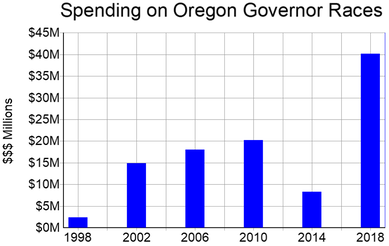We believe that Oregon needs campaign finance reform, so that government decisions are not driven by the interests of a few wealthy donors whose identities are hidden from the public. Such reform includes:
- limiting campaign contributions
- requiring that political ads name their largest funders
- providing low-cost ways for candidates and measures to communicate with voters, such as the Oregon Voters' Pamphlet
- providing limited public funding for candidates who agree to forego any large contributions
- making it illegal for public officeholders to make government decisions in exchange for campaign contributions

Oregon is one of only 5 states with no limits on political campaign contributions. Campaign spending in Oregon has skyrocketed by a factor of 10 (1,000%) since 1996.
Examples of such limits include:
The State Integrity Investigation of the Center for Public Integrity in November 2015 graded Oregon an overall "F" in systems to avoid government corruption. Oregon ranked 2nd worst of the 50 states in control of "Political Financing," beating only Mississippi.
THE OREGONIAN reported that candidates for the Oregon Legislature raise and spend more in their campaigns, per capita, than for any other state legislature, except New Jersey. The average spent in 2020 by the top 10 Oregon Senate candidates rose to over $953,000 each.; by the top 10 Oregon House candidates rose to over $925,000 each. Some candidates spent over $1 million, over $80 per vote received.
Examples of such limits include:
The State Integrity Investigation of the Center for Public Integrity in November 2015 graded Oregon an overall "F" in systems to avoid government corruption. Oregon ranked 2nd worst of the 50 states in control of "Political Financing," beating only Mississippi.
THE OREGONIAN reported that candidates for the Oregon Legislature raise and spend more in their campaigns, per capita, than for any other state legislature, except New Jersey. The average spent in 2020 by the top 10 Oregon Senate candidates rose to over $953,000 each.; by the top 10 Oregon House candidates rose to over $925,000 each. Some candidates spent over $1 million, over $80 per vote received.

The 2018 candidates for Governor spent over $40 million, more than doubling the previous record. One person, Phil Knight, gave $3.45 million to Knute Buehler, the Republican candidate. But the Democratic candidate, Kate Brown, also received multi-million dollar contributions from corporate-funded and union-funded PACs. Both major campaigns got over 70% of their funds from contributions of $10,000 or more and only 15% from contributions of under $1,000.
It appears that this 2018 spending record will likely be broken in 2022. Phil Knight has already contributed $1 million to a candidate for Governor.
It appears that this 2018 spending record will likely be broken in 2022. Phil Knight has already contributed $1 million to a candidate for Governor.
REQUIRING POLITICAL ADS TO NAME THEIR LARGEST FUNDERs

Voters need this information to judge the credibility of political ads. Oregon voters are in the dark.
For 93 years, Oregon had a law requiring that political ads at least identify their sources, but that law was repealed in 2001 by a Republican-majority Legislature and a Democratic Governor.
Examples of such requirements are in Section 6 of Initiative Petition 45 (2022).
PUBLIC FUNDING OF CAMPAIGNS

Several states and cities provide limited public funds to candidates who agree not to receive any large contributions.
Not shown on the map is Portland, which adopted a public funding system first applied in 2018. The Portland system "matches" with public funds small contributions from individual residents of Portland.
An example of such a system is in Sections 20-37 of SB 1526-1 (2022).


